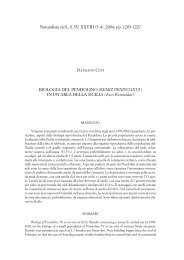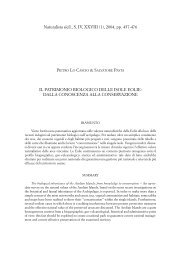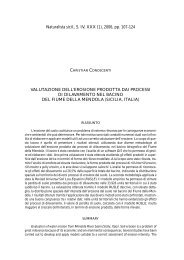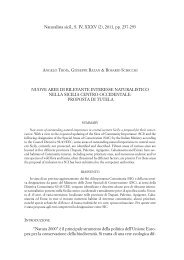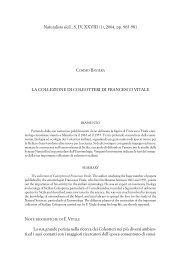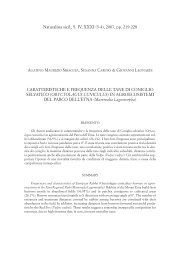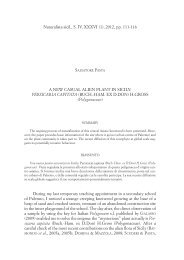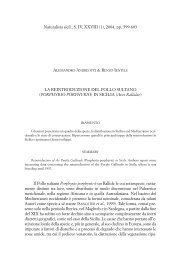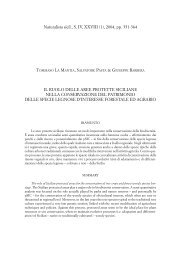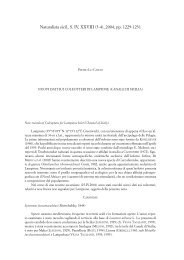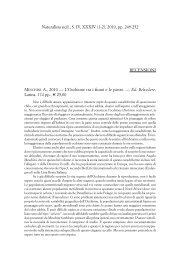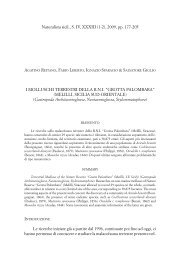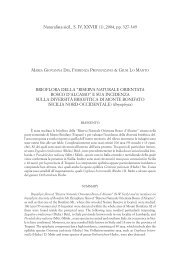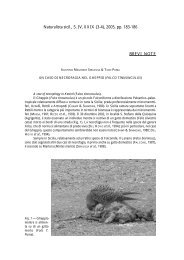2007,pp - Società Siciliana di Scienze Naturali
2007,pp - Società Siciliana di Scienze Naturali
2007,pp - Società Siciliana di Scienze Naturali
Create successful ePaper yourself
Turn your PDF publications into a flip-book with our unique Google optimized e-Paper software.
264 M. SKUHRAVÁ, V. SKUHRAVY´ & B. MASSA<br />
STUDY AREA<br />
Sicily is the largest island of the Me<strong>di</strong>terranean: with an area of 25,780<br />
km 2 (inclu<strong>di</strong>ng islets), it is only 3 km far away from Calabria, the most southern<br />
region of Italy, and 145 km from Tunisia. The climate is Me<strong>di</strong>terranean;<br />
accor<strong>di</strong>ng to the average temperatures recorded, three main climatic zones<br />
occur: 1) the coastal zone up to 200 m above sea level, with average winter<br />
temperatures over 10 °C and five months a year with more than 20 °C on average;<br />
this zone covers c. 10,480 km 2 (41.2% of the total area); 2) the warm temperature<br />
zone up to 1200 m, with average winter temperatures from 4 °C to<br />
9.9 °C and three months a year with more than 20 °C; this zone covers 14,200<br />
km 2 (55.7% of the total area); 3) the cold temperature zone, restricted to the<br />
areas over 1200 m; the average winter temperatures are below 4 °C and the<br />
average yearly temperature is below 20 °C. On Mount Etna, at over 2800 m,<br />
the temperature is below zero in winter, while it is below 10 °C in summer.<br />
The average annual rainfall is 600-700 mm; areas with the highest rainfalls<br />
(1200-1400 mm a year) are the Madonie and Nebro<strong>di</strong> Mts., the mountains<br />
around Palermo and Etna. In most of the inland areas, along the southern<br />
coast and islets, rainfall is lower (500-600 mm), only 300-400 in the plains of<br />
Gela and Catania and in the inland province of Trapani. Mountains represent<br />
24% of surface of Sicily, hills 56% and plains only 20%, the maximum altitudes<br />
achieved are by Etna volcano (3350 m) and the Madonie Mts (1979 m);<br />
the northern part of the island shows a regular range of mountains (Peloritani,<br />
Etna, Nebro<strong>di</strong> and Madonie). There are other <strong>di</strong>scontinuous reliefs near Trapani<br />
(Erice, Zingaro Nature Reserve), in the provinces of Agrigento and<br />
Palermo (Sicani Mts.), in the provinces of Caltanissetta and Enna (Erei Mts.)<br />
and in the provinces of Siracusa and Ragusa (Iblei Mts.) (Fig. 1).<br />
Sicily was once covered by abundant woods and Me<strong>di</strong>terranean maquis,<br />
reduced to small areas during <strong>di</strong>fferent foreign dominations and largely<br />
destroyed by the Romans, when the island became the “granary of the Empire”.<br />
After the downfall of the Roman Empire and the Moslem conquest, the<br />
noma<strong>di</strong>c pastoralism increased the agricultural decay and the erosion and<br />
desertification of the land. Cultivated olives are still the most widespread tree<br />
below 700 m, almonds are widely scattered, mostly on the poor soils of central<br />
Sicily, along the coasts citrus plantations are widely cultivated. The hills of the<br />
central and western areas are dominated by degraded vegetation, with scattered<br />
garigue, often characterized by Ampelodesmos mauretanicus or overgrazed<br />
open lands dominated by Asphodelus. The southeastern area (Iblei Mts.) is<br />
much dry on the calcareous plateau and cool along the narrow and deep valleys,<br />
where abundant vegetation, dominated by Quercus ilex, grows. On the<br />
western side, Sicani Mts. are covered by scattered thickets of Q. ilex and Q.



